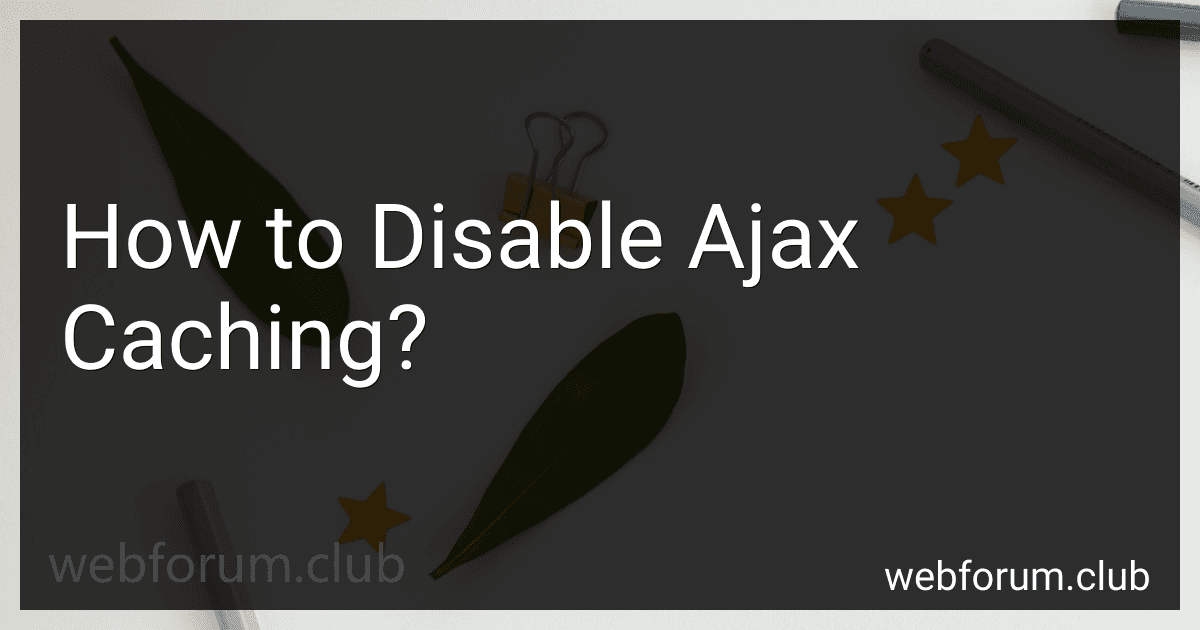To disable ajax caching, you can set the AJAX request cache property to false in your JavaScript code. This will prevent the browser from caching the results of the AJAX request, ensuring that each request fetches new data from the server. Additionally, you can add a timestamp or a random parameter to the AJAX URL to trick the browser into treating each request as unique. Another method is to use the no-cache header in the server response to instruct the browser not to cache the AJAX response. These techniques can help you avoid caching issues and ensure that your AJAX requests always retrieve the latest data from the server.
How to disable ajax caching for a specific API endpoint?
To disable caching for a specific API endpoint in an AJAX request, you can add a cache header to your AJAX call. You can set the cache option to false in the AJAX configuration.
Here's an example of how you can disable caching for a specific API endpoint in jQuery:
$.ajax({ url: 'https://api.example.com/endpoint', cache: false, success: function(response) { // Handle the response }, error: function(xhr, status, error) { // Handle any errors } });
In this example, setting cache to false in the AJAX call disables caching for that specific endpoint. This ensures that each call to the endpoint will be fresh and not cached by the browser.
Alternatively, you can also add cache-control headers to your server response for the specific API endpoint to control caching behavior on the client side.
Can ajax caching affect the user experience?
Yes, AJAX caching can have a significant impact on the user experience. When caching is implemented properly, it can improve the performance of the website by reducing load times and decreasing the amount of data that needs to be transmitted between the client and server. This can result in faster page loading times and a smoother overall experience for the user.
However, if caching is not implemented correctly, it can lead to issues such as stale or outdated content being displayed to users, which can be confusing and frustrating. Additionally, if caching is overly aggressive, it can prevent users from seeing the most up-to-date information on the website, which can also impact their experience.
Overall, proper implementation of AJAX caching can have a positive impact on the user experience, but it is important to strike a balance between performance improvements and ensuring that users have access to the most current information.
How to disable ajax caching for a specific theme?
To disable AJAX caching for a specific theme in WordPress, you can add the following code to your theme's functions.php file:
function disable_ajax_caching() { if ( is_admin() ) { return; }
wp\_script\_add\_data( 'jquery', 'data', '0', 1 );
$GLOBALS\['pagenow'\] = 'does-not-exist'; // Disables all AJAX requests
// Optionally, you can disable caching for specific AJAX requests like this:
// wp\_localize\_script( 'my-ajax-handler', 'my\_ajax\_object', array( 'ajax\_url' => admin\_url( 'admin-ajax.php' ), 'nonce' => wp\_create\_nonce( 'my-ajax-nonce' ) ) );
} add_action( 'init', 'disable_ajax_caching' );
This code will disable caching for all AJAX requests within your specific theme. Just make sure to replace 'my-ajax-handler' with the handle of your AJAX script if you want to disable caching for specific requests only.
How to clear ajax cache in Microsoft Edge?
To clear the AJAX cache in Microsoft Edge, you can follow these steps:
- Open Microsoft Edge browser on your computer.
- Click on the menu icon (three dots) in the top-right corner of the browser window.
- Select "Settings" from the drop-down menu.
- Scroll down and click on "Privacy, search, and services" on the left sidebar.
- Under the "Clear browsing data" section, click on "Choose what to clear".
- Check the box next to "Cached data and files" and any other data you want to clear.
- Click on the "Clear now" button to clear the cache.
Alternatively, you can use a keyboard shortcut to open the Clear browsing data menu in Microsoft Edge by pressing Ctrl + Shift + Delete. This will also allow you to clear the cache and other browsing data.
How to disable ajax caching in WordPress?
To disable Ajax caching in WordPress, you can add the following code to your theme's functions.php file or a custom plugin:
add_action( 'init', 'disable_ajax_caching' ); function disable_ajax_caching() { define( 'DONOTCACHEPAGE', true ); }
This code defines the DONOTCACHEPAGE constant, which tells WordPress not to cache the requested page. This should prevent Ajax requests from being cached as well.
Remember to clear your site's cache after adding this code to ensure that the changes take effect.
